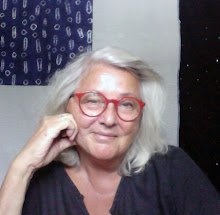 |
| Soulskin: Seeding the Prairie 1999 nylon, iron, copper, pigment 76 x 41 x 3 inches Susan Lordi Marker |
 |
| Damiana's Cloth 1991 rayon, silk, thread, 22 x 25 x 3 inches Susan Lordi Marker |
Damiana is the name of Susan Lordi Marker's great grandmother. In the piece above, although text is visible among the layers, we can't read it. Lordi Marker's use of text is as symbol of experience and knowledge. It communicates without naming.
 |
| Excavation: Soulskin #11 1997 linen blend, thread, dye, pigment 66 x 34 inches Susan Lordi Marker |
 |
| Excavation: Soulskin #11 1997 detail Susan Lordi Marker |
 |
| a remnant: Helionthus 2010 linen blend, gold leaf, thread, dyed 48 x 84 inches Susan Lordi Marker |
 |
| soulskin: cricket 2007 silk, dye, thread 96 x 84 inches Susan Lordi Marker |
 |
| the field is sewn 2010 silk, dye, thread 30 x 48 inches Susan Lordi Marker |
metals
cloth that is hung away from the wall so that it moves
it breathes
it casts a shadow
 |
| soulskin: sun, lake, dragonfly 2000 linen blend, dye, pigment, gold leaf, devore 90 x 54 inches Susan Lordi Marker |
Her work is about the essence of cloth.
"You must pull from within to access the universal" Susan Lordi Marker
 |
| soulskin: sun, lake, dragonfly detail Susan Lordi Marker |
 |
| Susan Lordi Marker in her prairie |
 |
| Seeding The Prairie: Detail Susan Lordi Marker |
She has been an influence.
The aesthetic of time is in each piece.
The aesthetic of labour.
The work of the work.
These pieces also remind us of the organic rhythm of nature, evoked here with these small dimensional marks.
The images in this post are from the official website for Susan Lordi Marker's fine art textiles and also from the Telos Portfolio on the artist, published in 2003 with an essay by Hildreth York. Go to the artist's website for more information and detail images. Thank you and acknowledgements to Ms York for her informative essay.





























